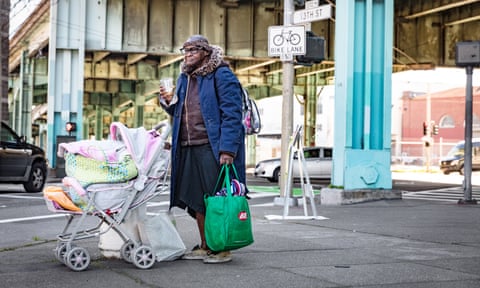More than half of the world’s population now lives in cities, but many people are residing in a state of limbo, leading a precarious existence on the margins, excluded from the promises of urban life. The world’s population is on the move more than ever before, driven by conflict and persecution, by the threat of environmental catastrophe and the lure of a better life, but cities simply aren’t prepared to receive their new arrivals.
Over the last two decades, Guardian photographer David Levene has documented the ways that people are living and working in cities around the world, how they make do with the bare minimum of resources to carve out space for themselves and their families in the most precarious of circumstances, and how cities are being polarised into places of haves and have-nots, with the right to the city relentlessly eroded.
On the publication of his new book of urban photographs, City, and an exhibition of his work at Foyles bookshop in London, we look at four very different cities that nonetheless share a common urban 21st experience of dislocation and resilience.
From the yurt encampments on the peripheries of Ulaanbaatar built by herders following the disastrous loss of livestock during extreme winters, to the self-built city of the Calais Jungle refugee camp, the growing homeless population of San Francisco forced on to the streets by the tech boom, and the dislocated town of Abu Dis, now cut off from Jerusalem by a huge concrete wall, Levene’s photographs reveal a shared experience: of human ingenuity against the odds.
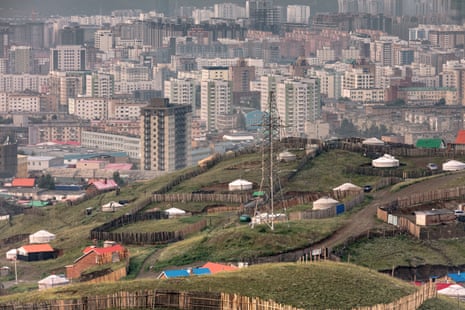
Ulaanbaatar
Sitting pensively on the edges of their beds, surrounded by the colourful trappings of a nomadic herder’s life, Altansukh Purev and his family contemplate the reality of their new home. The other side of the yak-skin walls of their traditional Mongolian yurt, or ger, are not the vast, empty plains of the rolling steppe that you might expect, but a sprawling scene of shacks and yurts, packed tightly together on the hilly outskirts of Ulaanbaatar.
These are the homes of around 600,000 former herders who, like Altansukh, have moved to the Mongolian capital over the past three decades. It is an unprecedented wave of migration that has seen 20% of the country’s people move to Ulaanbaatar, doubling its population and surrounding the city with new unplanned ger districts, ad-hoc shantytowns spreading ever further outwards into the hills.
These densely packed slums have no running water, mains electricity or sewage infrastructure. Without central heating, residents burn cheap coal to heat their homes throughout the freezing winters. And if they can’t afford coal, they are forced to burn rubbish and old tyres instead, leading to pollution levels five times worse than Beijing.
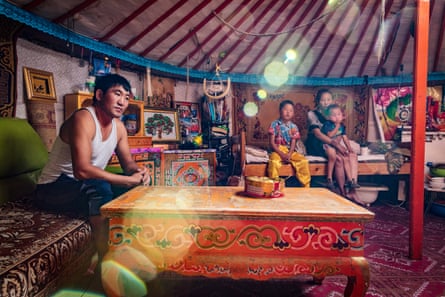
- Altansukh Purev, 38, with his wife, Narmandakh Sainjargal, and two of their four sons inside their ger
From Altansukh’s small plot of land, demarcated with a rickety wooden fence – itself a concept alien to a nomadic people used to pitching up on the plains wherever they please – the centre of Ulaanbaatar fades into the smoggy distance. It is a landscape of crumbling Soviet blocks and shiny new skyscrapers, giving way to a jumbled foreground of yurts, pylons and the wreckage of smashed-up cars where Altansukh’s children play. Other kids use a makeshift basketball hoop, precariously fixed beneath a pylon, or clamber on the nearby rubbish heap.
Like many of his neighbours, Altansukh, his wife and their four children moved here when their livestock perished one disastrously cold winter. They awoke one morning to find their 300 sheep had frozen to death, while their 40 cows had wandered far off into the snow and never came back.
It was the result of the dzud, Mongolia’s extreme weather phenomenon, where a summer drought is followed by a harsh winter, with temperatures ranging from 50C to -50C, causing many livestock to starve or freeze to death. From 2009 to 2010, 8.5 million animals perished. Climate change is only exacerbating the trend, pushing evermore people towards the city to find work.
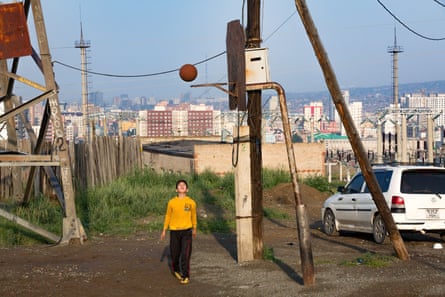
- A boy plays basketball in the Bayanzürkh district of Ulaanbaatar
Extreme weather isn’t the only challenge. Until the fall of the communist regime in the 1990s, herding was managed by Mongolia’s central government: livestock was collectively owned and there was a limit on the number of animals allowed in each herd. Crucially, there was also a central supply of fodder, distributed to herders during the harsh winters, meaning that the worst effects of the dzud could be avoided.
Since state support has vanished, the private herders have been under increased pressure to turn a profit, while a rise in the number of livestock has meant more animals grazing on less land. The result is more and more herders flocking to the capital to try and make a new life on its jumbled periphery, but with little chance of ever integrating into the city.
Mitsuaki Toyoda, who arrived here in 1998, and is now head of mission for Save the Children, which runs aid programmes in the city’s deprived suburbs, is frank about their prospects. “If you’re from the countryside with just secondary education and no relevant work experience, then what proper job can you get?” he says. “If you don’t have a proper job then it’s very difficult to get a bank loan. So you can’t purchase an apartment. Our conclusion is that the first generation of migrants will live in the ger districts for the rest of their lives.”
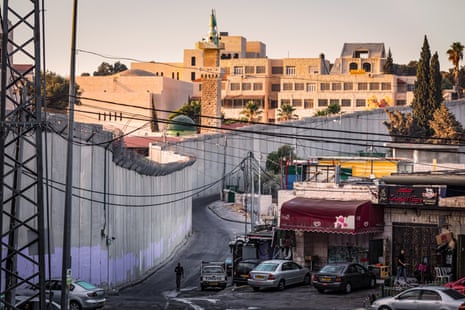
Jerusalem
The ruin of a newly built McMansion stands in the Palestinian town of Abu Dis in East Jerusalem, its oversized classical portico still presenting a grand face to the street, despite massive holes smashed into every side of the building. Behind the creamy stone wreck runs the 8m-high concrete backdrop of the West Bank barrier, the security wall eventually planned to stretch over 700km, crowned with the barbed-wire summit of an Israeli watchtower.
The wall is the reason that this grand house had to be made uninhabitable: the presence of a five-storey structure so close to the barrier presented too much of a threat for the Israeli Defence Force to tolerate. Things could be hurled over the wall, or people might even leap across, so the home had to be destroyed.

- Members of the Israeli Defense Forces on the Galizia Roofs in Jerusalem’s Old City
Such ruins are a common sight in Abu Dis, a town which, since the 1995 Interim Agreement on the West Bank and the Gaza Strip, has been classified as part of “Area B”, a place under joint Israeli and Palestinian control. It is where the Palestinians optimistically started to build their new parliament in 1996, in the form of an imposing stone edifice that still stands unfinished, a hollow shell just like the nearby house. It was designed so that Yasser Arafat could have a view of al-Aqsa mosque from his office window, but now all you see from the echoing ruin is the endless grey ribbon of the security wall.

- A newly built mansion in Abu Dis part-demolished by the IDF; the Orthodox Jewish neighbourhood of Mekor Baruch; teenagers doing parkour on the Galizia roofs


The arrival of the barrier has had a devastating effect on the residents of Abu Dis. The town had always seen itself as part of Jerusalem, as Brooklyn is to Manhattan, but now it feels like part of the West Bank, cut off from the city out of which it grew. Communities have been divided, residents have been separated from their places of work, house prices have plummeted, and the prospect of making the Palestinian capital here seems even more remote than it was two decades ago.
It is the same story for numerous towns and villages across East Jerusalem, home to 320,000 Palestinians who now make up 37% of the city’s population. Since the walls, fences and checkpoints went up in the early 2000s, in response to the suicide bombings of the second Palestinian intifada, the residents of East Jerusalem have been forced to live in a form of political limbo, suspended between Israel and the West Bank.

- Silwan, East Jerusalem
Half of East Jerusalem’s Palestinian labour force now works in West Jerusalem, according to the Jerusalem Institute for Policy Research, an independent Israeli study centre, and many live a divided life, working beyond the barrier by day and protesting by night. Residents complain of high taxes, fines and a lack of municipal services, while more than 80% of the city’s Palestinian children live in poverty, according to government statistics, compared with about 30% of Israeli children.
While the line of the concrete barrier is the most visible evidence of Jerusalem’s separation, the sense of division runs right through the historical core of the city. In the Muslim Quarter of the Old City, across the invisible barrier of the 1967 armistice line – where Israel captured the historic centre with its ancient holy sites from Jordanian control – the streets bristle with security and surveillance. CCTV cameras cover every corner, Palestinians are frequently stopped by patrolling Israeli Defense Forces soldiers and asked for their ID cards, while Israeli flags festoon the balconies of apartments now inhabited by nationalist religious Jews.
On a nearby rooftop, a troupe of young IDF recruits look across at the golden crown of the Dome of the Rock shrine, while a group of young Palestinian teenagers practice parkour. For a brief moment, the next generation of the two sides of this divided city manages to coexist in peace.

Calais
Karzan, an Iraqi nurse, sits on the floor of his makeshift shelter with his wife, Sharmin, and their one-and-a-half-year-old son, Hemn, bathed in a cold blue light from the plastic tarpaulin stretched over the wooden frame of their home. By November 2015, they had been living here for a month in the Calais refugee camp known as the Jungle. They had fled from their hometown of Kirkuk, Iraq, when Isis told Karzan that, if he didn’t agree to work as a nurse for their fighters, they would kill him.
He had paid a people smuggler $10,000 to get the family by train and car to Calais, but by this point they had no more money left. They were stuck there, in a space half the size of a small garden shed, together with Sharmin’s brother. When they’d first arrived, there were just a couple of families; by now there were 50 or 60. By the camp’s peak a few months later, the population would reach 10,000 people.
This sprawling temporary migrant city, which grew and grew until it was brutally bulldozed in November 2016, developed completely on its own. Unlike most refugee camps, there was no UN or Red Cross, no agency in charge to organise accommodation and services. Becoming home to refugees from Sudan, Afghanistan, Iraq, Syria, Ethiopia and Eritrea, the Jungle evolved as a melting pot of specific districts, with the self-built structures reflecting its residents different cultural traditions.

- A wide shot of the Calais Jungle, France; residents wait by the roadside, and queue inside the compound


The Sudanese families arranged their shelters in groups around communal eating spaces, with separate spaces for cooking together. The Afghans, on the other hand, generally lived more separately, but set up restaurants along an emerging commercial “strip” for social gathering. The Eritrean community, meanwhile, established a nightclub in a dome-shaped structure, which doubled as a theatre and gallery during the day.
Behind the shantytown fabric of tents, mud and abject squalor, there were the beginnings of a self-organised urban ecosystem. An informal high street emerged, lined with basic restaurants and shops, phone-charging booths and hairdressers, with people offering quick beard-trims while squatting in the street. Volunteers from across Europe built a school and a daycare centre for children, along with a library, a couple of mosques, a church, a refugee advice centre, an art therapy tent, medical clinics and even a radio station.

- Sharmin Hassan with her 18-month old son and her husband, who was a nurse in Iraq. The family travelled from Kirkuk to Calais
Along with gloves, ear-warmers and cigarettes, the shops stocked plenty of high-caffeine drinks. “All night they are running for the trains,” an Afghan shopkeeper said. “When they come back in the morning they need that energy.” He said he was subject to continual harassment by the police, who repeatedly asked him to produce a licence – to which he pointed out that, without these illegal shops, the residents of the Jungle would have to walk a 2km round trip to the nearest supermarket in Calais.
That was something the city was particularly keen to avoid. Long a destination for weekending Brits in search of cheap booze, Calais had by now become something of a ghost town, evacuated of the usual tourists, who were fearful of the encampment on its doorstep. Instead, it was suddenly home to hundreds of journalists in search of their own hot take on the Jungle.
“No, not you, too!” began the welcome letter at one hotel. “We’re fed up with the glitterati coming to feed off Calais’ misfortunes and treating the people stuck within its walls like lab rats … I wonder: which traps will you fall into? What story are you looking for? One thing I know for sure: your venture will be a failure.”

San Francisco
By 7am, the pews of St Boniface Catholic church in San Francisco are already full. Beneath the ornately painted ceiling and romanesque arches that spring from huge marble columns, bodies fill every space on the rows of wooden benches. But the congregation isn’t here to pray: they’ve come here to sleep.
The ornate nave of St Boniface is one of the few places where some of San Francisco’s 7,000-strong population of homeless people can come to rest, thanks to the Gubbio Project, a local non-governmental organisation. And it is one of the only such safe havens during the daytime. Most homeless shelters in the city close early in the morning and don’t allow people to stay during the day, unless they have a medical condition that requires it, while the city’s recent ban on sitting or lying on sidewalks in daytime means homeless people have to keep on the move.

- Homeless people sleep on the pews in St Boniface Catholic church, as part of the Gubbio Project
Yet the daylight hours provide their best chance for peace. Many of the city’s rough sleepers force themselves to stay awake at night for fear of being attacked or robbed, so save rest for the daytime. The queue outside St Boniface extends around the block by 6am every morning, with over a hundred people on average waiting to get some rest and access church amenities like bathrooms, blankets, clothing vouchers and haircuts.
As the rise of the Bay Area tech industry has driven up rents and the rate of evictions, San Francisco is struggling to house its low-income residents more than ever before. While statistics compiled by the US Department of Housing and Urban Development show that homelessness has been declining steadily across the country since 2007, the west coast is a different story. California is one of the five states to see the greatest increase, now accounting for 21% of the entire nation’s homeless population, with both Los Angeles and San Francisco dotted with encampments of tents and shacks across the city.

- Homeless people camping beneath the flyover opposite Airbnb’s HQ
In 2016, San Francisco declared a “shelter emergency”, a piece of legislation usually reserved for natural disasters such as floods and earthquakes, following similar moves in 2015 by Los Angeles, Portland, Seattle and King County, Washington. It was announced a week after city officials had cleared out a sprawling homeless encampment under a highway overpass where as many as 300 people had been living in tents and makeshift shelters.
A few blocks away from St Boniface church stands the gleaming white headquarters of Airbnb, a former factory building now kitted out with themed meeting rooms modelled on holiday rentals offered through the home-sharing platform – including tents and camper-vans. Across the street stands a line of tents of a different kind, home to community of around 20 people sheltering beneath the flyover.

- A tent outside Best Buy near 13th Street
Now valued at $30bn (£23bn), Airbnb has become the ultimate poster child of the “sharing economy”, yet it has been roundly accused of exacerbating the city’s homelessness problem by taking thousands of units out of the rental market. “We believe in a world where all seven billion of us can belong anywhere,” is the company’s motto – a sentiment that jars with the tents on its doorstep.
John Pobuda, a 58-year-old former US army private from Minnesota, is one resident of the undercroft below the deck of Interstate 80, who manages to scratch a living from what Airbnb throws in the trash. “Cans, bottles, extension cords, piping, copper – it’s amazing what people throw away,” he says. “I’ve salvaged about $400 worth from that dumpster. I guess you could say that makes me part of the technology industry, but I don’t feel like it.”
Own a limited edition print by Guardian photographer David Levene
Live: Guardian photographer David Levene in conversation at Foyles, London on 4 December 2017
Follow Guardian Cities on Twitter, Facebook and Instagram to join the discussion, and explore our archive here
